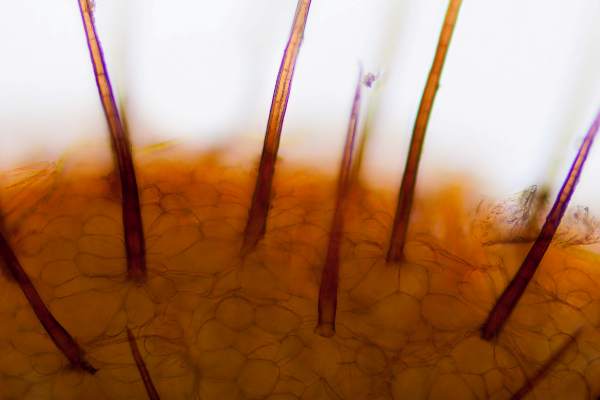Cheilymenia fimicola (De Not. & Bagl.) Dennis
Phylum: Ascomycota - Class: Pezizomycetes - Order: Pezizales - Family: Pyronemataceae
Distribution - Taxonomic History - Etymology - Identification - Reference Sources
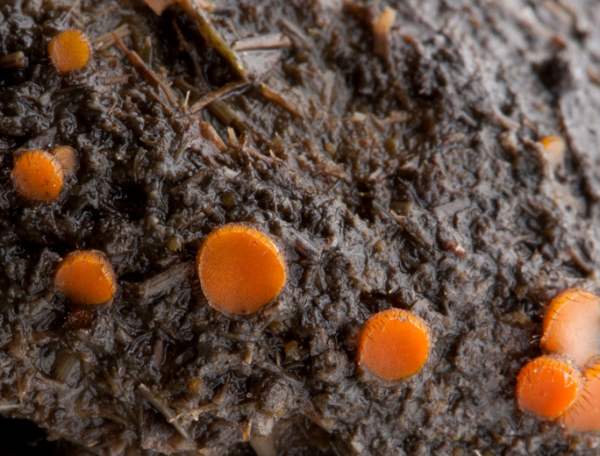
Cow-pats and dung from other farm animals and wild herbivores are home to a host of macro and micro fungi, but one of the more spectacular colonisers of cow-pats, is Cheilymenia fimicola. This tiny disc-like ascomycete fungus belongs to the order Pezizales. (This fungus is inedible - but who in their right mind would be tempted to try it?) Although individually tiny, it is as if coprophilous disc fungi find safety in numbers - often these and related ascomycete species swarm over dung in their hundreds and sometimes in their thousands.
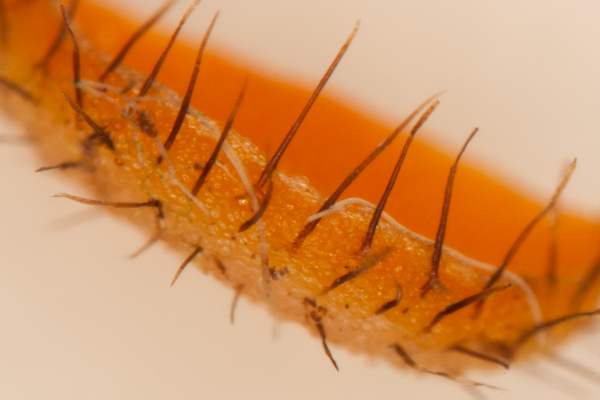
Distribution
This colourful dung-loving ascomycete is a very common sight on all kinds of herbivorous animal dung (especially cow dung) throughout Britain and Ireland as well as in other European countries.
Taxonomic history
Originally described as Arrhenia granulata in 1866 by Italian mycologists Giuseppe De Notaris (1805 - 1877) and Francesco Baglietto (1826 – 1916), in 1978 this species was transferred to the genus Cheilymenia by British mycologist Richard William George Dennis (1910 - 2003).
Synonyms of Cheilymenia fimicola include Lachnea minima Grove, Arrhenia fimicola De Not. & Bagl., Peziza coprinaria Cooke, Lachnea coprinaria (Cooke) Sacc., Cheilymenia coprinaria (Cooke) Boud., and Cheilymenia coprinaria var. minima (Grove) Ramsb.
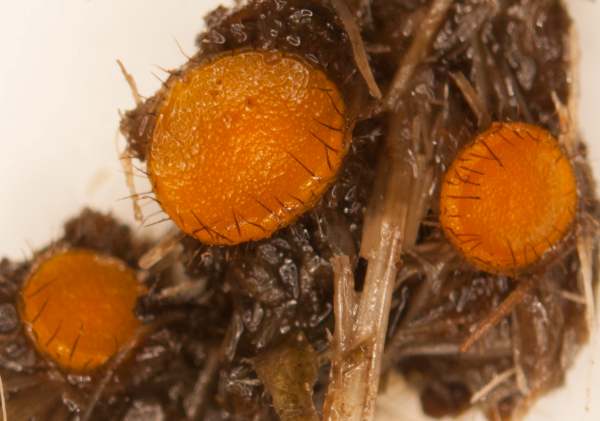
Etymology
The specific epithet fimicola means 'living on dung'.
The key to identifying to species level the various species of Cheilymenia and Scutellinia (the other main group of eyelash-fringed disc fungi) of which there are close on 50 known in Britain and Ireland, is by microscopic examination of asci, spores and any hairs or 'lashes' that cover the infertile surface.
Identification guide
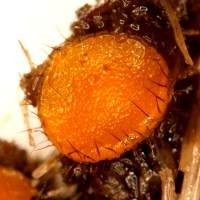 |
FruitbodyFlat or shallowly concave discs, 2 to 4mm across and 0.5 to 1.5mm tall; orange; sessile; usually in groups and sometimes in swarms on dung. The fertile (upper) surface is bright orange and smooth; the lower (infertile) surface is slightly paler and covered in fine hairs, especially around the margin, where they stand more or less upright. |
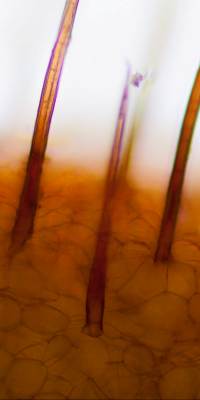 |
HairsUp to 500µm (0.5mm) long and 25-30µm in diameter at the base tapering to a sharp point; variably septate; forked at the base. |
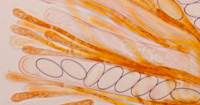 |
AsciiEight spores per ascus. Asci tips inamyloid. ParaphysesCylindrical with slightly swollen tips 7-8µm diameter; septate . |
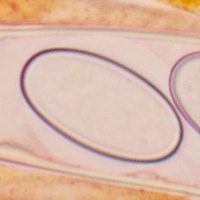 |
SporesEllipsoidal, smooth, thin-walled, 17-20 x 10-12µm; hyaline. Spore printWhite. |
Odour/taste |
Reportedly not distinctive - although given their particular habitats who would want to try sniffing and tasting such offerings? |
Habitat & Ecological role |
Saprobic, on all kinds of herbivore dung, but especially on cow-pats. |
Season |
May to early November in Britain and Ireland. |
Similar species |
Scutellinia scutellata, Common Eyelash fungus, has blackish hairs around its rim and it grows on rotten timber. Several other ascomycetous disc fungi also colonise animal dung. Few can be identified from macroscopic features alone, and so microscopic examination of asci, spores and other cell structures is usually necessary. |
Reference Sources
Fascinated by Fungi, 2nd Edition, Pat O'Reilly 2016, reprinted by Coch-y-bonddu Books in 2022.
Dennis, R.W.G. (1981). British Ascomycetes; Lubrecht & Cramer; ISBN: 3768205525.
Breitenbach, J. & Kränzlin, F. (1984). Fungi of Switzerland. Volume 1: Ascomycetes. Verlag Mykologia: Luzern, Switzerland.
Medardi, G. (2006). Ascomiceti d'Italia. Centro Studi Micologici: Trento.
Dictionary of the Fungi; Paul M. Kirk, Paul F. Cannon, David W. Minter and J. A. Stalpers; CABI, 2008
Taxonomic history and synonym information on these pages is drawn from many sources but in particular from the British Mycological Society's GB Checklist of Fungi.
Acknowledgements
This page includes pictures kindly contributed by David Kelly.
Fascinated by Fungi. Back by popular demand, Pat O'Reilly's best-selling 450-page hardback book is available now. The latest second edition was republished with a sparkling new cover design in September 2022 by Coch-y-Bonddu Books. Full details and copies are available from the publisher's online bookshop...
